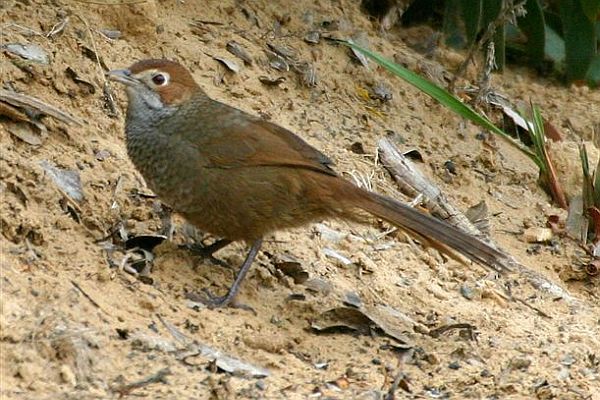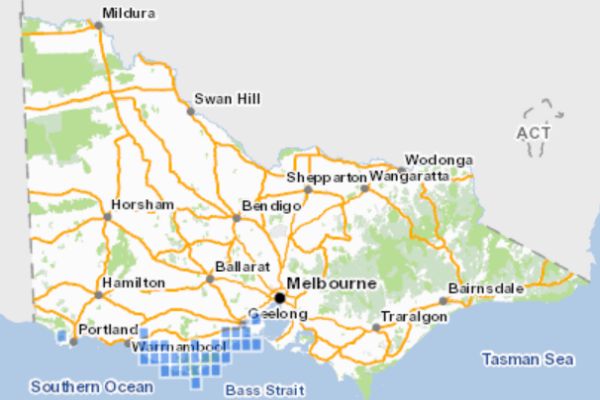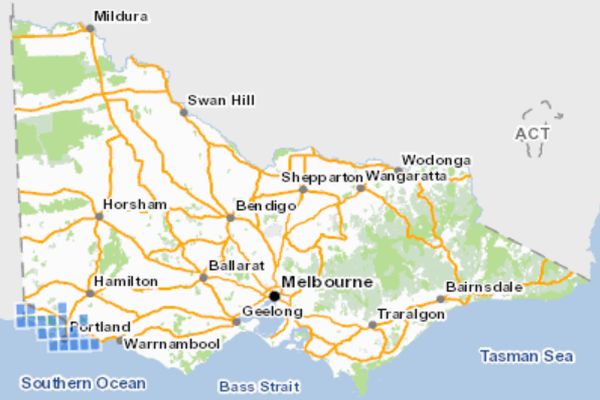Rufous Bristlebird
Rufous BristlebirdDasyornis broadbenti caryochrous (Otways sub-species) Dasyornis broadbenti broadbenti (Coorong sub-species) | |
|---|---|
| Kingdom: | Animalia |
| Phylum: | Chordata |
| Class: | Aves |
| Order: | Passeriformes |
| Family: | Dasyornithidae |
| Status | |
| World: | Least Concern (IUCN 2025) |
| Australia: | Vulnerable (Not Listed under EPBC Act) |
| Victoria: (Coorong sub-species) | Endangered (FFG Threatened List 2025) |
| Victoria: (Otways sub-species) | Vulnerable (FFG Threatened List 2025) |
| Profiles | |
| Victoria: | FFG Action Statement No. 49 |

The Rufous Bristlebird is a small ground-dwelling bird which can be observed running or flying short distances whilst darting in and out of moderately dense understory in which it shelters and feeds.
There are three related species of Bristlebird in the genus Dasyornis, all endemic to Australia;
- Eastern Bristlebird Dasyornis brachypterus - (far eastern Victoria, New South Wales and Queensland).
- Rufous Bristlebird Dasyornis broadbenti - (Anglesea to south-east South Australia).
- Western Bristlebird Dasyornis longirostris (Western Australia).
The Rufous Bristlebird is predominantly dark brown above with a long tail and rich rufous coloured crown, nape and ear coverts. Its rump and centre of wings have varying shades of cinnamon–brown colouration. It has a pale grey-brown underside with scalloped markings on its throat and chest. A light grey marking surrounds the eye and extends to the bill. It is similar in size to the common Blackbird and distinguishable due to its longer tail, rufous colouring, distinctive call and limited ability to fly.
Distribution
Three sub-species of Rufous Bristlebird Dasyornis broadbenti are recognised;
- Dasyornis broadbenti caryochrous (Otways sub-species) occurring from Anglesea to Naringal East (near Warrnambool).
- Dasyornis broadbenti broadbenti (Coorong sub-species) from Port Fairy to the Coorong in South Australia).
- Dasyornis broadbenti litoralis, known from historic records in south west Western Australia is now presumed extinct.


Ecology & Habitat
Habitat preference is determined by a combination of floristic composition and vegetation structure, with key elements being understory density, height (> 1 metre) and connectivity between habitats. Bristlebird population densities can reflect levels of past disturbance, which include grazing, clearing and burning.
A study of Rufous Bristlebird habitat at Port Campbell National Park in 1992 found preferred habitat comprises a moderately dense understory described as Leptospermum-Baumea (tea-tree – rush) open heath sub-community which contained a high floristic diversity with a low incidence of weeds. Distribution of the Rufous Bristlebird within the park was reflected in this vegetation type which had a period of greater than 25 years since the last fire.
Whilst most records are near coastal vegetation Rufous Bristlebirds have been recorded up to 40 km inland in dense gullies and forested areas with suitable understory. At many sites Prickly Tea-tree Leptospermum continentale or Manuka Leptospermum scoparium form part of the dense understory associated with preferred Rufous Bristlebird habitat. This type of vegetation is particularly important along many roadsides where remnants of intact vegetation exist; these areas provide links between habitat areas and connectivity within the population. In the Port Campbell area, Rufous Bristlebirds have been able to utilise new areas of habitat created by direct seeding of Leptospermum and other species along unused roads and 20metre wide shelter belts linking known habitat areas.
Feeding & nesting
The Rufous Bristlebird feeds primarily on ground-dwelling invertebrates, although details of its diet are not well known. Nests are built close to the ground, in tussocks or low shrubs and the Rufous Bristlebird is usually observed within close proximity to cover.
Population status
An objective in the FFG Action Statement No. 49 is to confirm that there are at least 1000 Rufous Bristlebirds in each of the populations either side of the Warnambool gap in distribution.
In 2000, the Action Plan for Australian Birds estimated the population of the Otways sub-species to be 4000 birds – decreasing (Garnett 2000). Population estimates for the Coorong sub-species were estimated to be at least 17,800 (Seymour et al. 2003). The IUCN Red List (2016) stated the overall population estimate for both sub-species was 4,000 to 28,000 (IUCN 2020) with a decreasing trend. In the 2024 population estimates there has been a decline down to 2,700 to 19,000 (IUCN 2025).
The rate of decline in the Otways sub-species requires further studies. Fragmentation of habitat is of concern as coastal developments continue to be popular.
Threats
Loss / fragmentation of habitat
A high percentage of Rufous Bristlebird habitat is now contained within Coastal and National Parks in south-west Victoria, however habitat quality and connectivity is often compromised where coastal developments occur such as towns and ribbon housing development along the coastal corridor.
Development nodes both within and outside National & State Parks can result in localised fragmentation of the Rufous Bristlebird population. Clearing for housing, roads, infrastructure, frequent burning for fire protection, and weed invasion can reduce or remove suitable habitat.
Incremental loss of habitat
Many of the negative impacts on habitat are incremental and may be considered minor or small scale by the various proponents, however when viewed in a broader landscape context, the net impact can be quite substantial resulting in pockets of localised extinction.
In the long-term, incremental fragmentation could have a major influence on the future range and viability of this species. This presents a challenge to planning authorities and land managers both within public and private land to recognise and adequately manage the sensitive habitat requirements of the Rufous Bristlebird.
Predation/road kill
The Rufous Bristlebird is a poor flier and due to its ground dwelling behaviour, it can fall prey to Cats and Red Foxes. It is also susceptible to road mortality, particularly where roadside vegetation provides the main habitat.
Conservation & Management
The conservation status of Rufous Bristlebird Dasyornis broadbenti broadbenti (Coorong) was re-assessed from Near Threatened in 2013 (DSE 2013) to Endangered in 2020 as part of the Conservation Status Assessment Project – Victoria (DELWP 2020).
The conservation status of Rufous Bristlebird Dasyornis broadbenti caryochrous (Otways) was re-assessed from Near Threatened in 2013 (DSE 2013) to Vulnerable in 2020 as part of the Conservation Status Assessment Project – Victoria (DELWP 2020).
Identified actions requiring on-going implementation for the conservation of the Rufous Bristlebird
Monitor about 10 sites throughout the Rufous Bristlebird's Victorian range. (Sites should be chosen so that both disturbed and undisturbed areas where the taxon occurs are represented). Sites chosen are Lorne Angahook State Park, Otway National Park, Port Campbell National Park, Bay of Islands Coastal Park, Discovery Bay Coastal Park, Lower Glenelg National Park.
Survey the Rufous Bristlebird's range to establish population densities and distribution.
Determine an appropriate fire regime in Port Campbell N. P. & Lower Glenelg National Park if the species is found to be fire dependent.
Liaise with local government and VicRoads to erect slow down signs as appropriate where foraging areas of established pairs are dissected by minor roads.
Develop education and information material incorporating the results of research, survey and monitoring. Information should be supplied to park managers, local government bodies, community groups, the CFA and landholders concerning status of species.
Develop and enhance a system of corridors along gullies where the Rufous Bristlebird lives or which link known populations. (This action is most appropriate for the Heytesbury and Timboon areas and Port Campbell and Nirranda).
Research to improve management of Rufous Bristlebird populations.
Determine the bird's critical habitat requirements at all locations. Identify any common features within heathland and inland gully habitats. Factors to be assessed include ground litter, floristics, vegetation structure and successional stages after fire.
Encourage reporting of Rufous Bristlebird sightings to the Victorian Biodiversity Atlas.
Determine what constitutes a viable habitat link for the Rufous Bristlebird in terms of width, continuity and habitat quality. This has been identified for Port Campbell and Anglesea areas.
Institute research to determine the degree of inbreeding in isolated populations due to the lack of gene flow.
Gather information on natality, mortality, recruitment and dispersal from colour-banded birds.
Outcomes
In 1992 a study into Rufous Bristlebird survey and habitat analysis – Port Campbell National Park, was completed. The report identifies critical Rufous Bristlebird habitat in the Port Campbell area (Belcher 1992).
A study to model Rufous Bristlebird habitat was conducted in the Anglesea area in 2004. The spatial model clearly delineated areas predicted as highly suitable rufous bristlebird habitat, with evidence of potential corridors linking coastal and inland populations via gullies. Conservation of this species will depend on management actions that protect the critical habitats identified in the model (Gibson et al. 2004)
Projects & Partnerships
Habitat creation & restoration
Since 1993 a substantial amount of habitat restoration has been undertaken in the Port Campbell area. A report "Brushing for bristles” Habitat corridors for the Rufous Bristlebird incorporated direct seeding of unused roads and creation of shelterbelts on private property. Revegetation using species favoured by the Rufous Bristlebird combined with the direct seeding technique results in high density vegetation, creating new habitat and re-connecting habitat long roadsides with remnant patches of bush and the Port Campbell National Park. (Du Guesclin et al. 1992)
References & Links
DELWP (2020) Provisional re-assessments of taxa as part of the Conservation Status Assessment Project – Victoria 2020, Department of Environment Land Water and Planning, Victoria. Conservation Status Assessment Project – Victoria
DSE (2013) Advisory List of Threatened Vertebrate Fauna in Victoria , 2013. Department of Sustainability & Environment, 8 Nicholson Street, East Melbourne 3002.
Belcher, C. (1992) Rufous Bristlebird survey and habitat analysis – Port Campbell National Park, , report to Department of Conservation & Environment, Melbourne.
DuGuesclin, P., Smith, S., O’Shea, W., and Dennis, C. (1992) In: Wildlife conservation and management on private land, Chapter 21. 1992. "Brushing for bristles” Habitat corridors for the Rufous Bristlebird.
Emison,W.B., Beardsell, C.M., Norman, I., Loyn, R.H. and Bennett, S.c. (1987), Atlas of Victorian Birds, Department of Conservation Forests & Lands and RAOU, Melbourne.
Field Guide to Birds of Australia, Simpson & Day, 6th edition, Published by Penguin Books Australia Ltd.
FFG Threatened List (2025) Flora and Fauna Guarantee Act 1988 - Threatened List - March 2025, Department of Energy, Environment and Climate Action (DEECA) , Victoria.
Flora & Fauna Guarantee, Victoria. Action Statement No. 49; Rufous Bristlebird 2013.
Gibson, L.A., Wilson, B.A., Cahill, D.M., Hill, J. (2004) Spatial prediction of rufous bristlebird habitat in a coastal heathland: a GIS‐based approach. First published:07 April 2004 https://doi.org/10.1111/j.0021-8901.2004.00896.x Journal of Applied Ecology. Volume41, Issue2, April 2004, Pages 213-223.
IUCN (2025) BirdLife International. 2024. Dasyornis broadbenti. The IUCN Red List of Threatened Species 2024: e.T22704510A253994507. https://dx.doi.org/10.2305/IUCN.UK.2024-2.RLTS.T22704510A253994507.en. Accessed on 12 June 2025.
VBA (2020) Victorian Boidiversity Atlas, Department of Environment, Land, Water and Plannin, Victoria.
More Information
See also: Eastern Bristlebird

